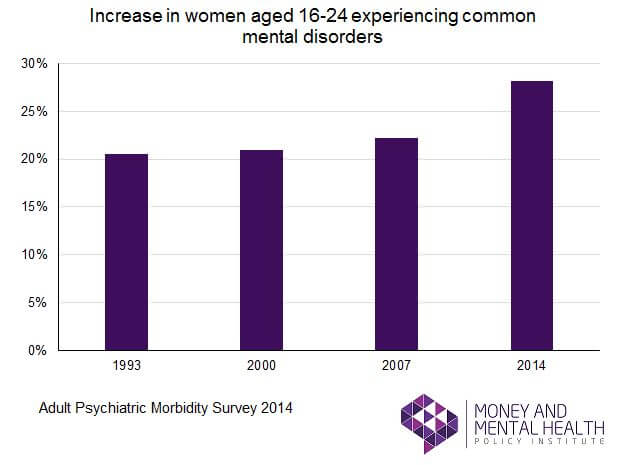
Merlyn Holkar, Research Officer, Money and Mental Health
Young women in mental health crisis
New national study shows a worrying rise in prevalence of
mental health problems for young women
New data, released today by NHS Digital, shows a steady increase in rates of common mental health problems in women since the financial crisis. The Adult Psychiatric Morbidity Survey shows that more women are experiencing conditions like depression, generalised anxiety disorder, phobias and obsessive compulsive disorder, which can cause emotional strain and make day-to-day life difficult. This trend was largely driven by a sharp rise in prevalence for young women. More than one in four (28%) women aged 16-24 experienced a common mental health problem in 2014, up from one in five (22%) when the survey was last conducted in 2007.

Across all age groups, common mental health problems were more prevalent amongst women than men, but the difference is particularly stark for young women (aged 16-24), who are nearly three times as likely to suffer as men of the same age.

Life has been difficult for many people since the onset of the financial crisis in 2007, and young people have been particularly hard hit. However, today’s data suggest that the economic climate has had a much greater impact on the mental health of young women than young men. The proportion of young men experiencing common mental health disorders fell slightly between 2007 and 2014, from 13% to 10%, compared to a 6 percentage point increase in levels among young women.
What’s making young women ill?
While all young people have been affected by a less stable jobs market and insecure housing, today’s data suggests this is having a particular impact on young women’s mental health. Although the unemployment rate has been consistently higher for young men than young women, women are more likely to be affected by underemployment – where a worker would like to take on more hours but their employer doesn’t need them. Women are also substantially more likely to work in the public sector, where they will have been affected by spending cuts.
At home, the situation is no easier for young women. Rising house prices have led to a significant decline in the number of young people owning their own homes. While nearly a quarter (23.4%) of 16-24 year olds owned their own home in 2001/02, fewer than one in ten young people (8.9%) had a home to call their own in 2013/14. Combined with the decline in social housing stock, this has left more young people relying on the private rented sector, where a third of all homes fail to meet the government’s Decent Homes Standard (1). The anxiety and distress caused by substandard, insecure and unaffordable housing is undoubtedly having an impact on young people’s mental health.

A toxic cocktail
The situation for all young people has clearly been difficult, so the question that remains is why the mental health impacts for women have been so much worse. Young women are under significantly more financial pressure than young men, with 39% saying they struggle to make their money stretch to the end of the month, compared to 27% of young men (2). At the same time as experiencing these day-to-day financial strains, there is real pressure on young women in particular to present an idealised image of themselves on social media (3)(4), creating an inevitable disparity between the lives they feel they are living and those they see portrayed by their friends online.
A symptom of this can be increased spending and focus on the short term, as young women struggle to maintain appearances, which can ultimately lead to further financial problems, debt and yet more worry (5). The combination of day-to-day insecurity and the idealised world of social media appears to be creating a toxic cocktail for young women’s mental health.
What’s next?
More work is needed to understand the full story behind these statistics. We’ll be looking closely at the full data when it becomes available next year – but it’s clear that the mental health of young women must be made a priority, and mental health services, as well as debt and welfare advice, funded to meet this rising demand.
References
1 Shelter, Safe and Decent Homes: Solutions for a better private rented sector, 2014 http://england.shelter.org.uk/__data/assets/pdf_file/0003/1039530/FINAL_SAFE_AND_DECENT_HOMES_REPORT-_USE_FOR_LAUNCH.pdf
2 Young Womens Trust, No Country for Young Women, 2016 http://www.youngwomenstrust.org/assets/0000/4258/No_country_for_young_women__final_report.pdf
3 Girlguiding. Girls’ wellbeing explored: Understanding pressures and resilience. 2016. https://www.girlguiding.org.uk/globalassets/docs-and-resources/research-and-campaigns/girls-wellbeing-explored-think-resilient-report.pdf
4 Elian Fink, Praveetha Patalay,Helen Sharpe, Simone Holley, Jessica Deighton and Miranda Wolpert. Mental Health Difficulties in Early Adolescence: A Comparison of Two Cross-Sectional Studies in England From 2009 to 2014. Journal of Adolescent Health 2015. 56;5.
5 Is social pressure burning a hole in Gen O’s pockets? Aviva. 2016.
http://www.aviva.co.uk/investments/save-smarter/modern-day-spending/article/social-pressure-burning-hole-gen-os-pockets/
